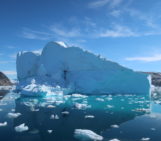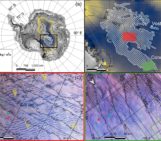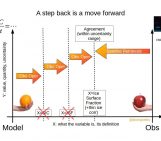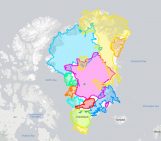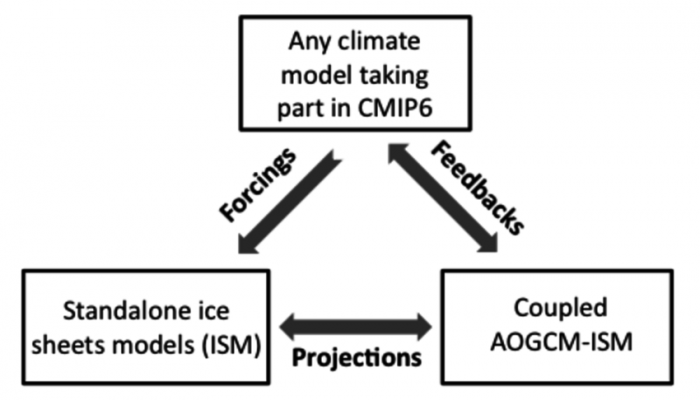
The Antarctic and Greenland ice sheets are major players in future sea level rise. Still, there is a lot about these ice sheets we do not understand. Under the umbrella of the World Climate Research Programme, the international scientific community is coming together to improve ice sheet modelling efforts to better grasp the implications of climate change for ice sheet evolution, and consequently, sea level rise…
What are ice sheets?
An ice sheet is a massive chunk of glacier ice that sits on land – covering an area greater than 50,000 square kilometres (or 1.6 times the size of Belgium) by the official definition. Currently, the only two ice sheets on Earth are in Antarctica and Greenland. Ice in ice sheets flows from inland toward the coast under gravity. Due to the geothermal heat flux, ice sheets are usually warmer at the base than on the surface. When basal melting occurs, the melted water lubricates the ice sheet and accelerates the ice flow, forming fast-flowing ice streams. When ice flows down a coastline into the ocean, it may float due to buoyancy. The floating slab of ice is called an ice shelf (see these previous posts for more on ice shelves). The boundary that separates the grounded ice and floating ice is called the grounding line.
Why do we care about ice sheets?
The most uncertain potential source of future sea level rise is the contribution from ice sheets. According to observations, the Greenland and Antarctic ice sheets have contributed approximately 7.5 and 4 mm of sea level rise respectively over the 1992-2011 period, and the contribution is accelerating. Knowing how the ice sheets will behave under future emission scenarios is crucial for risk assessment and policy-making (see this previous post for more on Antarctic ice sheets).
In addition to the direct impact on sea level rise, ice sheets interact with other components of the climate system. For example, ice discharge affects ocean circulation and marine biogeochemistry; changes in orography influence the atmosphere condition and circulation. In turn, the ice sheets gain mass primarily from snow fall, and lose mass through surface melting, surface sublimation, basal melting and ice discharge to the ocean, which are influenced by atmospheric and oceanographic processes. In Antarctica, the mass loss due to basal melting and iceberg calving is larger than snowfall accumulation. The Greenland Ice Sheet is also losing mass through iceberg calving and surface water runoff.
What’s CMIP?
Global coupled climate models are developed by different groups of scientists around the world to improve our understanding of the climate system. These models are highly complex, representing interactions between the ocean, atmosphere, land surface and cryosphere on global grids. The Coupled Model Intercomparison Project (CMIP) is a collaborative framework which provides a standard experimental protocol for the different models. The protocol includes a range of greenhouse gas emissions scenarios for future climate projections. Model output is made publicly available and forms the basis for assessments such as the Intergovernmental Panel on Climate Change (IPCC) reports. The latest phase (CMIP6) is underway now.
What’s ISMIP6?
Ice sheets were considered as passive elements of the climate system previously and were not explicitly included in the CMIP process. However, observations of the rapid mass loss associated with dynamic change in ice sheets highlight the need to couple ice sheets to climate models. New developments in ice sheet modelling allow previously-omitted key processes which affect ice sheet dynamics on decadal timescales, such as grounding-line migration and basal lubrication, to be simulated with higher confidence.
ISMIP6 is an international effort designed to ensure that projections from ice sheet models are compatible with the CMIP6 process, bringing together scientists from over twenty institutions (Fig. 2). It aims to improve sea level projections, exploring sea level contribution from the Greenland and Antarctic ice sheets in a changing climate and investigating interactions between ice sheets and the climate system.
ISMIP6 Experiments
As shown in Figure 1, the objectives of ISMIP6 rely on three distinct modeling efforts:
- CMIP atmosphere-ocean general circulation models (AOGCM) without an ice sheet component
- standalone dynamic ice sheet models (ISMs) that are driven by forcing provided by CMIP
- fully coupled atmosphere-ocean-ice sheet models (AOGCM-ISMs).
In the first phase, ISMIP6 will compare output from different ice sheet models run in ‘standalone’ or ‘offline coupled’ mode. This means that they receive forcings from the climate model components like the ocean and atmosphere without feeding back. These experiments will be used to explore the uncertainty associated with ice sheets physics, dynamics and numerical implementation. In particular, ISMIP6 is currently focused on gaining insight into the uncertainty in ice sheet evolution resulting from the choice of initialization methods (the initMIP efforts for the Greenland and Antarctic ice sheets) and understanding the response of the Antarctic ice sheet to a total loss of the ice shelves (ABUMIP).
The model output of the initMIP simulations for Greenland is now publicly available.
ISMIP6 workshop
Regular meetings are organised to update and facilitate communication between the participants. The most recent workshop was hosted in the Netherlands during 11 – 13 September 2018. The topic of the workshop was “Developing process-based projections of the ice sheets’ contribution to future sea level.” Participants aimed to evaluate the output of the CMIP6 climate models and obtain forcing for standalone ice sheet model experiments. During the workshop, scientists made progress on establishing the experimental protocols for the ice sheet model simulations that will be discussed in the IPCC sixth assessment report.
Further reading
- Nowicki, S. M. J., Payne, A., Larour, E., Seroussi, H., Goelzer, H., Lipscomb, W., Gregory, J., Abe-Ouchi, A., and Shepherd, A. (2016): “Ice Sheet Model Intercomparison Project (ISMIP6) contribution to CMIP6“, Geosci. Model Dev., 9, 4521-4545, doi: 10.5194/gmd-9-4521-2016.
- Goelzer, H., Nowicki, S., Edwards, T., Beckley, M., Abe-Ouchi, A., Aschwanden, A., Calov, R., Gagliardini, O., Gillet-Chaulet, F., Golledge, N. R., Gregory, J., Greve, R., Humbert, A., Huybrechts, P., Kennedy, J. H., Larour, E., Lipscomb, W. H., Le clec’h, S., Lee, V., Morlighem, M., Pattyn, F., Payne, A. J., Rodehacke, C., Rückamp, M., Saito, F., Schlegel, N., Seroussi, H., Shepherd, A., Sun, S., van de Wal, R., and Ziemen, F. A. (2018): “Design and results of the ice sheet model initialisation experiments initMIP-Greenland: an ISMIP6 intercomparison“, The Cryosphere, 12, 1433-1460, doi: 10.5194/tc-12-1433-2018.
- ISMIP6 website
- CMIP6 website
Edited by Lettie Roach and Clara Burgard
 Sainan Sun does her postdoctoral research with Frank Pattyn at Université Libre de Bruxelles (ULB). She achieved her doctoral degree in 2014, majoring in ice sheet modeling at Beijing Normal University, Beijing, China. In her PhD study, she applied the BISICLES ice sheet model to Pine island glacier, Aurora drainage basin and Lambert-Amery drainage basin to describe the dynamical response of the Antarctic ice sheet to perturbations in boundary conditions. For the project at ULB, she aims to investigate the ice shelf features based on data acquired in Roi Baudouin ice shelf, Antarctica, and to estimate the potential instability of the Antarctic ice sheet using the f.ETISh ice sheet model. Contact Email: sainsun@ulb.ac.be
Sainan Sun does her postdoctoral research with Frank Pattyn at Université Libre de Bruxelles (ULB). She achieved her doctoral degree in 2014, majoring in ice sheet modeling at Beijing Normal University, Beijing, China. In her PhD study, she applied the BISICLES ice sheet model to Pine island glacier, Aurora drainage basin and Lambert-Amery drainage basin to describe the dynamical response of the Antarctic ice sheet to perturbations in boundary conditions. For the project at ULB, she aims to investigate the ice shelf features based on data acquired in Roi Baudouin ice shelf, Antarctica, and to estimate the potential instability of the Antarctic ice sheet using the f.ETISh ice sheet model. Contact Email: sainsun@ulb.ac.be




